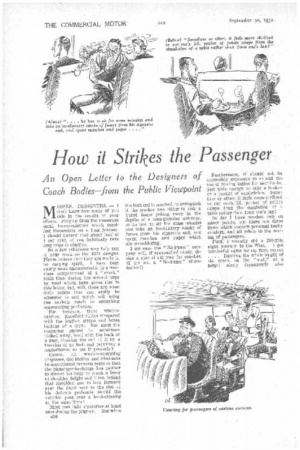How it Strikes the Passenger
Page 48

Page 49

If you've noticed an error in this article please click here to report it so we can fix it.
An Open Letter to the Designers of Coach Bodies—from the Public Viewpoint
.M ESSRS. DESIGNERS, — I don't know how many of you ride in the results of your efforts. Judging from the numerous small inconveniences which manifest themselves on a long journey, I should hazard that about half of 1 per cent, of you habitually take long trips in coaches.
SO a few criticisms may help you in your work on the 1933 designs. Please believe that they are made in no carping spirit. I have been vastly more uncomfortable in a firstclass compartment of a " crack " train than during the several trips by road which have giVen rise to this letter, but, still, there are some little points that can easily be attended to and which will bring the modern coach to something approaching perfection. .
For instance, these window catches. Excellent things compared with the leather straps and brass buttons of a train. But must the operating gadget be sometimes tucked away, level with the back of a seat, clearing the end of it by a fraction of an inch and requiring a contortionist to use it properly?
Cannot all window-operating dingusses, doo-hickies and what-nots be apportioned between seats so that the passenger-in-charge has neither to distort his .body to reach a lever at shoulder height and 2 ins, behind that shoulder, nor to lean forward over the front seat to the risk of his delicate proboscis should the vehicles pass over a level-crossing at the sometime?
Most men light cigarettes at least once during the journey. But when E30 the butt-end is reached, to extinguish it the smoker has either to risk a burnt finger poking away in the depths of a semi-globular ash-tray, or he has to sit for some minutes and take an involuntary smoke of fumes from his cigarette end, and spent matches and paper which are smouldering.
I am sure the " No-Fume " company will, if approached nicely, design a special ash-tray for coaches. (I am not a "No-Fume" shareholder !) Furthermore, it should not be impossibly expensive to extend the use of folding tables for seat-backs, Just wide enough to take a book— or a packet of sandwiches. Somehow or other, it feels more civilized to eat one's 2d. packet of potato crisps from the simulation of a table rather than from one's lap !
So far I have touched only on minor points, but there are three items which concern personal bodily comfort, and all relate to the seating of passengers.
First, I recently did a 200-mile night journey to the West. I got wonderful value for my fare, except . . . . Running the whole length of the coach, on the "wall," at a height nicely (apparently also
deliberately) calculated to bruise my biceps at each gentle bump, was a length of beading. It seemed (and still seems) a silly place for the lighting circuit or bell wire. If there had been an elbow-rest, it would have been better, for then, at least, I could have braced myself in a higher position and so avoided the contact with the tenderest part of my arm.
If you would build more seats with their backs extended in a curve forwards at each end, and give us a small elbow-rest at each end of the double seat, the extra few inches filched from us would be amply compensated for by the added comfort.
The other two items are more or less interdependent.
Everybody knows how exasperatingly uncomfortable it is to sit with the knees bent for any length of time. The natural reaction to this cramped stance is to slide downwards and forwards on the seat, and to thrust oat the feet to ease the cramped muscles by stretching them.
But on most coaches I have used, it is usually impossible to thrust out the feet, even gently, because of the small clearance between the " deck " and the bottom of the seat in front. Usually, this clearance is very small, and if one pushes one's feet into it, not a little difficulty is often experienced in .getting them out again undamaged.
Furthermore, a wedging action comes into play, which is aggravated by every jolt of the vehicle, and the shins—other highly sensitive parts—press continually against the bottom of the seat in front.
A 6-in. or 8-in. clearance (perhaps with a well also under the seat) will enable an average-sized foot to burrow underneath and so induce another trifle of passenger comfort.
This is not all, however. When one slides down (as has very occasionally happened to me), one's head immediately leaves the opulentfeeling neck-nape cushion and the discomfort is "swapped," end-forend. So, coupled with legroom, may I plead for more adjustable hea drests ?
Even without the legroom, this would be a boon for the undersized, or duck's-diseased passenger (you know that one?, . . Tail too near the ground, of course!). Surely this passenger's comfort should be studied even more than the others'. His ton-mileage is undoubtedly less than that of the average or outsized traveller with a consequently greater show of profit to the coach operator !
There is probably a fallacy tucked away in that last bit of reasoning. If there be, and you find it, please don't swamp the Editor with letters pointing it out. Just remember that although I am only, I am, nevertheless, sincerely yours,
A PASSENGER.






































































































